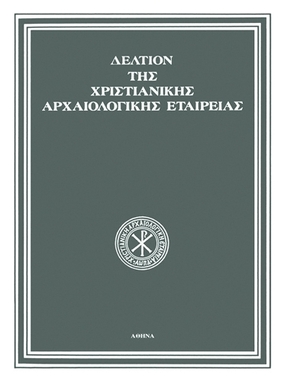Επισήμανση τοιχογραφιών του εργαστηρίου των θηβαίων ζωγράφων Γεωργίου και Φράγκου Κονταρή στην περιοχή της γενέτειράς τους
Part of : Δελτίον της Χριστιανικής Αρχαιολογικής Εταιρείας ; Vol.40, 2001, pages 191-208
Issue:
Pages:
191-208
Parallel Title:
Identification of Wall-paintings by the Workshop of the Theban Painters Georgios and Frangos Kontaris, in the area of their birthplace
Section Title:
Articles
Abstract:
Thebes is the place of origin of three major 16th-century painters, Frangos Katelanos and the Kontaris brothers, Georgios and Frangos, as is attested by inscriptions on four dated ensembles by them: in the chapel of St Nicholas in the Lavra monastery on Mt Athos (1560), by Frangos Katelanos; in the church at Krapsi in Epirus (1563) and the lite of the Barlaam monastery at Meteora (1566), by Georgios and Frangos Kontaris; in the church of the Transfiguration at Veltsista in Epirus (1568), by Frangos Kontaris. These painters are the only eponymous representatives of the painting movement that developed in mainland Greece in the sixteenth century, as a rejoinder to contemporary Cretan painting. The movement was formerly characterized as the Theban School, after the home town of the three painters, and later as a local Epirote School or School of Northwest Greece, since many important works have been located in this part of the country. To date, examples of the School's activity in the region of Thebes were very limited, and indeed not in its immediate environs but in its wider area, in the katholikon of the Galatakis monastery on Euboea (1586) and in the lite of Hosios Meletios at Kitharonas (late sixteenth a), the wall-paintings in which are attributed to the workshop of the Kontaris brothers. It should be noted here, however, that Thebes is unfortunately one of the few towns in Greece where historical vicissitudes and earthquake damage in the late nineteenth century resulted in the total destruction of its monuments, as is known from the sources and revealed by finds in excavations. One such find is the decorative zone in the lower part of the apse of a church discovered there recently. Ostensibly of little importance, this would have passed virtually unnoticed were it not for the fact that this particular decorative motif is one of the typical elements present in all the works from the Kontaris workshop. The same decorative zone had been located earlier, in the well-known Byzantine church of St George at Akraiphnio near Thebes, above which was uncovered the outstanding representation of Prophet Elijah before the mouth of the cave, analogous to that in the Philanthropinon monastery. The painting has been attributed to the Kontaris workshop. In the village of Kokkino, a short distance from Akraiphnio, paintings from the same workshop have also been identified in the churches of St Nicholas and St Athanasios. In the first, which has been in ruins for years, the few figures preserved were headless, thus limiting observations. However, the recent noting of exactly the same figures, intact, in the adjacent cemetery church of St Athanasios, indicates that the same team worked in both monuments. Unfortunately the decoration covers only the low parts of the walls and is restricted to individual figures, while narrative scenes are entirely lacking since the rest of the church is covered by later wall-paintings. Nevertheless, from examination where possible of the facial features, the drapery, the colours and the type of inscriptions, in relation to other products of the Kontaris brothers' workshop, there is, we believe, little doubt that these wall-paintings and the previous ones, should be ascribed to it. The absence of narrative scenes in the monuments discussed is compensated for by the excellent decoration of the church of St Marina at Platanaki, which has been known for years. On re-examining it today, we are able to ascribe it to the workshop of the same painters. Very recently the wallpaintings in the church of St Sozon at Orchomenos were revealed, sadly in poor condition but also creations of the same workshop. The identification of the decoration in these monuments new to research, augments the evidence of the operation of the Kontaris brothers' workshop in the area of their birthplace and virtually verifies their presence in Thebes. The few examples of painting found in Thebes and its environs attest the existence of noteworthy artistic activity there in past centuries. Moreover, as recent archival research has shown, in the sixteenth in particular, Thebes was a populous and prosperous city. However, the limited extent and repertoire of the products of the workshop considered here does not resolve the issue of whether or not the School flourished in the Thebes region, which would account for its reputation, so that the painters were invited repeatedly to decorate Epirote monuments. Perhaps the only observation that can be made for the present is that the Kontaris team was working concurrently in the two regions, Epirus and Thebes. The painter Georgios Kontaris certainly maintained contact with his home town, as has been noted already, since he signs originally as ecclesiarch and later as sakellarios of the Metropolis of Thebes.
Subject:
Subject (LC):




